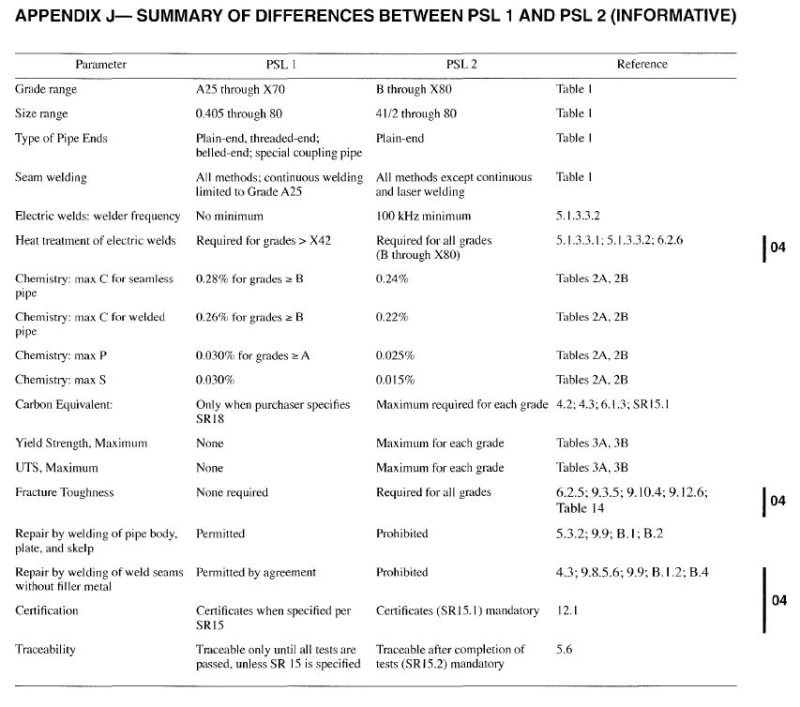Navigation
Install the app
How to install the app on iOS
Follow along with the video below to see how to install our site as a web app on your home screen.
Note: This feature may not be available in some browsers.
More options
Style variation
-
Congratulations cowski on being selected by the Eng-Tips community for having the most helpful posts in the forums last week. Way to Go!
You are using an out of date browser. It may not display this or other websites correctly.
You should upgrade or use an alternative browser.
You should upgrade or use an alternative browser.
API 5L
- Thread starter Amr Srag
- Start date
- Status
- Not open for further replies.
Amr Srag,
The delivery condition for PSL-1 pipe is at the option of the manufacturer, unless specified in the purchase order. For PSL-2 pipes, the delivery condition should be specified in the purchase order, as well as indicated in the grade name. See below for a difference of the two product specification levels.

"Thinking is the hardest work there is, which is probably the reason why so few engage in it."
-Henry Ford
The delivery condition for PSL-1 pipe is at the option of the manufacturer, unless specified in the purchase order. For PSL-2 pipes, the delivery condition should be specified in the purchase order, as well as indicated in the grade name. See below for a difference of the two product specification levels.

"Thinking is the hardest work there is, which is probably the reason why so few engage in it."
-Henry Ford
I have been wondering the same thing. With the properties being required to be the same, why would I care to specify a delivery condition for PSL2? For my company's purposes, we indicate that any of the PSL2 delivery conditions are acceptable, and don't require a specific one, but I'm wondering if there are properties of the different delivery conditions not specified in API 5L that we should be aware of.
We are building gas compressors, so our scope is limited to piping of about 16" and less.
We are building gas compressors, so our scope is limited to piping of about 16" and less.
- Thread starter
- #5
Thank you all very much for your answers, so as conclusion there is no selecting criteria for M,Q or N they are the same (only a method of manufacturer don't effect by any way the material properties and no method is better than other. thus, whether i specified in the pipeline data sheet M or Q they are the same ?
Not exactly:
As we mentioned before, the API grade refers to minimal yield stress required (SMYS), and there are an specific interval where yield strength and Ultimate tensile strength can belong to each grade, but, there are other properties like toughness (represented by CVN Energy or DWT), ductility (represented by elongation in tension test and shear fracture in impact test), where API only specifies minimal values for each grade and each one could be improved by different delivery condition and the user must be establish optimal levels based on the requirements of the engineering design for the specific pipeline.
Other properties like hardness will be different in each delivery condition, maybe higher in Quenched and tempered steel, and this property are important where you could have friction, erosion, impacts but shall be well controlled if there is probability of SSC or hydrogen damage by example.
The use of Q grades involves also the need for more controlled welding procedures, to avoid undesirable effects in each weld.
Finally, some studies try to establish relationships between microstructure (the microstructure is probably the main difference between each delivery condition) and corrosion resistance and how could be improved.
Summary: You must order M, N or Q grades when the engineering design for the specific pipeline demands it.
As we mentioned before, the API grade refers to minimal yield stress required (SMYS), and there are an specific interval where yield strength and Ultimate tensile strength can belong to each grade, but, there are other properties like toughness (represented by CVN Energy or DWT), ductility (represented by elongation in tension test and shear fracture in impact test), where API only specifies minimal values for each grade and each one could be improved by different delivery condition and the user must be establish optimal levels based on the requirements of the engineering design for the specific pipeline.
Other properties like hardness will be different in each delivery condition, maybe higher in Quenched and tempered steel, and this property are important where you could have friction, erosion, impacts but shall be well controlled if there is probability of SSC or hydrogen damage by example.
The use of Q grades involves also the need for more controlled welding procedures, to avoid undesirable effects in each weld.
Finally, some studies try to establish relationships between microstructure (the microstructure is probably the main difference between each delivery condition) and corrosion resistance and how could be improved.
Summary: You must order M, N or Q grades when the engineering design for the specific pipeline demands it.
A last thing: you need specify N, M, Q..... If you need PSL2 pipe, since PSL 1 no requires.
When PSL1, when PSL2???
R. again: engineering design and... Maybe a rule of thumb: liquids at room temperature or moderately different, could be PSL1. Others services, PSL2.
When PSL1, when PSL2???
R. again: engineering design and... Maybe a rule of thumb: liquids at room temperature or moderately different, could be PSL1. Others services, PSL2.
- Thread starter
- #8
- Status
- Not open for further replies.
Similar threads
- Locked
- Question
- Replies
- 8
- Views
- 620
- Locked
- Question
- Replies
- 5
- Views
- 789
- Locked
- Question
- Replies
- 2
- Views
- 403
- Locked
- Question
- Replies
- 0
- Views
- 1K
